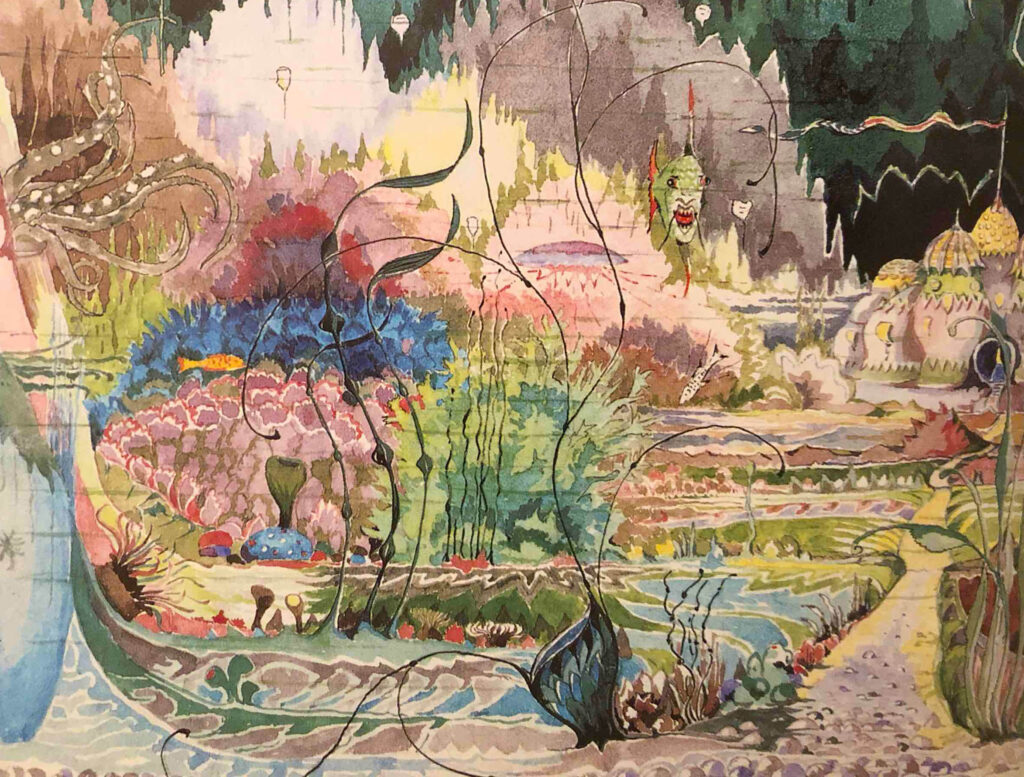J. R. R. Tolkien
1938
(The realm of Faërie is no frivolity, but a place of profound enchantment, offering glimpses into deep mysteries and addressing fundamental human desires.)

“Lies, though breathed through silver”. It was September 1931. Little could J. R. R. Tolkien have guessed that this insult of myth, from the mouth of his hard-headed friend C. S. Lewis, would spur him to a rebuttal that would blossom into the most sustained and thoughtful argument for the value of fiction in the history of literature. And, while we’re at it, little could Lewis have guessed that Tollers’ argument, as they walked in a park behind Magdalen College, Oxford, would plant a mustard seed that would eventually transform Lewis into a myth-maker himself, not to mention the most celebrated writer on God (that myth of all myths) in the twentieth century. What was that argument? What path could possibly carry a wayfarer from the valley where myths are childish propaganda, to the hilltop where they are powerful elicitors of fleeting joy and hint at truths beyond our comprehension?
 Thankfully, years after that discussion, Tolkien preserved that argument in an extended essay, “On Fairy-stories”. It was written in 1938, as a break from work on The Lord of the Rings. He left the hobbits to their shenanigans at the Prancing Pony pub in Bree, and, as he puts it in a 1964 introduction, “I had then no more notion than they had of what had become of Gandalf or who Strider was; and I had begun to despair of surviving to find out”. (Indeed he had much to learn– at that point Strider was called “Trotter” and he was a hobbit!). One suspects some mischief in this statement, though, for the 80-page essay he then wrote exhibits absolutely no “despair”, but rather that simmering inspiration of the mythopoet in his element—the crafter of fantasy as images make their appearance and narrative extends into the unknown—the wielder of the golden scepter of a world of his own creation. He knew something was afoot. He may not have known where the hobbits were headed, but he knew it was in the Perilous Realm; that world once called Faërie, the land suffused with things ancient and sublime and beautiful and terrible. The author of “On Fairy-stories” could write that essay precisely because he was standing at once in the academic world of Oxford philology and literary criticism, and also in the enchanted world of elf, dwarf, balrog, troll, Dark Lord, and Eru. His mission in the essay is at least partly to bring the worlds together, to show us how he could be one person in both of them, and specifically to show us the tremendous value of the Enchanted one, even as our society is becoming increasingly mechanized and rationalized and disenchanted.
Thankfully, years after that discussion, Tolkien preserved that argument in an extended essay, “On Fairy-stories”. It was written in 1938, as a break from work on The Lord of the Rings. He left the hobbits to their shenanigans at the Prancing Pony pub in Bree, and, as he puts it in a 1964 introduction, “I had then no more notion than they had of what had become of Gandalf or who Strider was; and I had begun to despair of surviving to find out”. (Indeed he had much to learn– at that point Strider was called “Trotter” and he was a hobbit!). One suspects some mischief in this statement, though, for the 80-page essay he then wrote exhibits absolutely no “despair”, but rather that simmering inspiration of the mythopoet in his element—the crafter of fantasy as images make their appearance and narrative extends into the unknown—the wielder of the golden scepter of a world of his own creation. He knew something was afoot. He may not have known where the hobbits were headed, but he knew it was in the Perilous Realm; that world once called Faërie, the land suffused with things ancient and sublime and beautiful and terrible. The author of “On Fairy-stories” could write that essay precisely because he was standing at once in the academic world of Oxford philology and literary criticism, and also in the enchanted world of elf, dwarf, balrog, troll, Dark Lord, and Eru. His mission in the essay is at least partly to bring the worlds together, to show us how he could be one person in both of them, and specifically to show us the tremendous value of the Enchanted one, even as our society is becoming increasingly mechanized and rationalized and disenchanted.
The essay is of course not a defense of Tolkien’s own tales or world—that idea is anachronistic. His examples hail from places like Asgard and Logres, the worlds of Thor and Arthur. It is an encomium for any written work that fully and unabashedly participates in the Otherworld of fantastic imagination. Thus our reception of this essay must stand aside from our reception of the Tolkien legendarium in particular (although of course this essay can certainly illuminate, for anyone curious or incredulous, why someone would spend his life creating a world). Still, one cannot help noticing two further connections. First, The Lord of the Rings is a test case for Tolkien’s claim in the essay that fantasy, when done properly, will access particular human yearnings in a way that perhaps no other art can. If positive popular reception of his own fantasy could be distilled to a single point, a sort of average or common reaction, maybe it would be that of Clyde Kilby:
“For a century at least the world has been increasingly demythologized. But such a condition is apparently alien to the real nature of men. Now comes a writer such as John Ronald Reuel Tolkien and, as remythologizer, strangely warms our souls.” -Meaning in the Lord of the Rings”, Shadows of Imagination, (1969)
Call it strange warming if you like, although I would say it arrests more than it warms; regardless, it is exactly what Tolkien had been saying of the power of myth and our spiritual need for it.
The second connection is the flip side of the first: just as positive reception appears to corroborate Tolkien’s view, negative reception sometimes demonstrates that we are still very much in need of his exhortation. I don’t mean that there is a problem with people who do not like fantasy—there are several possible reasons for this, and Tolkien himself acknowledged that it was not for everybody. What I am saying is that, apart from matters of taste, some sorts of negative criticism betray the very spirit or attitude that Tolkien was at pains to undermine. They are not disagreeing with the point of “On Fairy-stories”, but appear manifestly ignorant of it, to their own confusion and even bizarre bitterness. Edmund Wilson could not have been more of a foil for the essay when he, in exasperation at the exuberance of the reception of The Lord of the Rings, wrote, “The answer is, I believe, that certain people—especially, perhaps, in Britain—have a lifelong appetite for juvenile trash.” (The Nation, 14 April 1956). Michael Moorcock likewise sees none of the depth others have found in the tale, but nicknames it “Epic Pooh”, full of fuzzy consolation and detestable orthodoxy (1978). In an almost unbelievable instance of The Guardian’s typical funneling of all things through the lens of a contemporary progressive political agenda, Damien Walter could understand nothing of the metaphysics of the Lord of the Rings, could apprehend no numinous significance, but saw everything as a crude and cartoonified piece of this-world political propaganda. Only thus could he write,
Isn’t it more likely that the orcs, who live in dire poverty, actually support Sauron because he represents the liberal forces of science and industrialisation, in the face of a brutally oppressive conservative social order? -“Tolkien’s myths are a political fantasy” (2014).
Wilson worries that Tolkien’s myth fosters immaturity, Moorcock complacency, and Walter social injustice. Their biggest error is not in the particulars of their worries, but that they got distracted from the main point of it all, or (more sadly) were unable to see it. Tolkien’s work is not beyond criticism, nor even beyond political predilections, and The Lord of the Rings is not the quintessence of myth. But these commentators missed out on what the tale is all about. They are like aliens who go to a baseball game and wonder why everyone is dying to run around in a circle. Their skills at invective would undoubtedly have served them well if they had understood the book they read; but alas, as the level or angle of their criticisms suggests, they did not. They—indeed many of us—live in a far duller, flatter world than “On Fairy-stories” challenges us to inhabit. This dulling and flattening is our fault as a society.
“On Fairy-stories” should at least make us pause before we sweep the shards of Narsil into the dustbin (on account of their being broken, of course). Progress must be demonstrated to be so—one is not progressive just because one is abandoning old things. If the idea of a king returning to his rightful place is conservative in some sense, that is not, not yet anyway, a reason to vilify it—especially when it is occurring in that Otherworld where we can be assured that he is that Good King of which, in this world, we have only heard tales.
Summary
INTRODUCTION
He presents three questions to be addressed: (1) What are fairy-stories? (2) What is their origin? (the least important question to the author); and (3) What is the use of them? (the most important question to him).
To preface his answers, he presents more of an illustration than a definition, although he will tell us soon that this is all that can properly be done of such a mysterious place:
The realm of fairy-story is wide and deep and high and filled with many things: all manner of beasts and birds are found there; shoreless seas and stars uncounted; beauty that is an enchantment, and an ever-present peril; both joy and sorrow as sharp as swords. In that realm a man may, perhaps, count himself fortunate to have wandered, but its very richness and strangeness tie the tongue of a traveller who would report them. And while he is there it is dangerous for him to ask too many questions, lest the gates should be shut and the keys be lost.
FAIRY-STORY
Fairy stories are not properly stories about “fairies” or “elves”, although they certainly do include them (though not the modern tiresome corruptions that render them cutesy and little). Rather, they are stories of the whole world: that of Faërie, Elfland, the Perilous Realm– not a physical place you can get to, but an alternate reality. It is a land of serious magic (enchantment that is always to be respected— not “the vulgar devices of the laborious, scientific magician”). The place is indefinable by its very nature; definition would destroy its power. “Supernatural” is not quite the right word, because fairies are in a sense even more natural than man— we are the ones who are supernatural, or further removed from nature than they are.
A few things fairy-stories are not. They are not travelers’ tales, as you cannot travel to Faërie purely geographically. They are not dream-tales, as this cheats and makes the tale occur “in one’s head”, whereas fairy-stories must be presented as true (in that world). The fairy-story is the “realization… of imagined wonder”. Its magic speaks to “primordial human desires”, such as to probe space and time, or to communicate with animals. However, pure beast-fables are not fairy-stories, as these do not have enchantment but are simply populated with anthropomorphized talking animals.
ORIGINS
One way to look for origins is to take particular elements of fairy-stories, such as detached hearts and wicked stepmothers, and trace them back in time. Another, related objective is to treat similar stories, or multiple stories with ancestor-descendent relationships, as “the same”. Tolkien prefers, in contrast, to treat each story as it is, to respect it as a whole thing in itself. It is truer to the fairy-story to (to paraphrase George Webbe Dasent) take the “soup” of the story for what it is, and not obsess about looking for source materials, i.e. “the bones of the ox out of which it has been boiled”. We will never be able to unravel the histories of fairy-story— perhaps a thread here and there, but not a whole picture. Of course the history involves a combination of inheritance (borrowing in time), invention (independent evolution), and diffusion (borrowing in space). Of these, only invention is really important or deeply explanatory.
The origin of Faërie must have been the origin of description itself— the adjective. Once we could abstract and imagine and separate qualities from objects, we could subcreate— we could put things together in new combinations by a force of will. Mythology should be seen as subcreation, rather than as mere interpretation or explanation of stuff in the real world. From the beginning of thought and expression we invested natural things with personality— we made gods and spirits. Sometimes, but only occasionally, we see in mythology something genuinely deserving of worship, “higher” mythology that could be called religion. Perhaps the two were once one, mythology and religion, but got sundered, and in our stories sometimes get re-fused. This is speculation. Regardless, “The Pot of Soup, the Cauldron of Story, has always been boiling.” In all of this, Tolkien is fiercely holistic— he sees the central thing about fairy-story to be unanalyzable, a gestalt. You will never discover it by looking at history or taking apart elements of the story. You have to read the story and experience it. Wondrous things that have good story value are put into the pot of soup, and boil there with all the other things that had been put there in the past. Even historical personages and practices can get in there and morph into something bigger than they were in history— and they are there, and appreciated, because they have good story value, not because they were true or not true in a historical sense. Arthur was some sort of modest leader, but emerged, after boiling in the pot a good long time, “The King of Faërie”. Another thing that happens is that oldness gradually gets laid upon the stories and their elements, and thereby confers even more Faërie value, as antiquity has a charm of its own.
CHILDREN
Despite the popularity of the idea, there is no special connection between children’s minds and fairy-stories. Children don’t seem to like them any better or understand them any better than adults do. The association is merely “an accident of our domestic history”. Some think that the child’s ability to suspend disbelief is the operative skill— but a suspension of disbelief is not really required unless the story fails to enchant. A good subcreator will make you believe the Secondary World while you’re in it. Adults might lose the ability to believe in this way, and perhaps that is why they sometimes think fairy-stories are silly and relegate them to children. Some believe that fairy-stories are more appropriate for children because children are more credulous, or have a less developed notion of what is possible and what is not. Tolkien, by contrast, believes that children do not really tend to care whether the events in fairy-stories “really happened”; fairy-stories, whether to children or adults, are not primarily about what is possible, but about desire— whetting and fulfilling it. Some of these desires are general and universal, while others are particular to people. As for his own childhood encounters with Faërie, Tolkien didn’t really care about Carroll’s Wonderland or pirates, but he loved bows and arrows, forests, and “glimpses of an archaic mode of life”. More specifically, he was enchanted by “Red Indians… the land of Merlin and Arthur… the nameless North of Sigurd of the Völsungs, and the prince of all dragons.” He loved dragons most of all— desired them intensely. But he always maintained an important separation between this world and the Other world, and was irritated when people tried to relate them superficially, or use the first to cheapen the second (e.g., “snowflakes are prettier than fairy drops”, or calling an actual lizard a dragon). Tolkien also disapproved of the silly, prudish, or preachy adaptations for children. Viewing fairy-stories as juvenilia can in this way lead to “falsification of values”, warping the ideals the stories are meant to convey and should properly convey.
All of this about “not being just for children” having been said, there is a sense in which a certain humility and innocence, a “heart of a child”, is necessary to appreciate fairy-stories fully; but adults can certainly cultivate this as well. We should write fairy-stories for adults, and of course make ones that are suitable for children as well, like we do with any sort of literature or writing. In fact, children should read a bit beyond what they can fully process.
Granted that fairy-stories can be good for adults as well as children. But what are they good for in particular? This is his most important question in the essay. He answers with four things: Fantasy, Recovery, Escape, and Consolation.
FANTASY
Imagination is properly considered “the mental power of image-making”. But to be able to use imagination to create a work of art that can achieve “the inner consistency of reality”, i.e. “which commands or induces Secondary Belief”, in a different world, that sub-creative act, that “elvish craft”, the elicitor of enchantment, that he calls Fantasy. Fantasy, precisely because it is comprised of images not in the Primary World, is high art, and perhaps “the most potent” art form in that regard. Fantasy has an advantage, that of “arresting strangeness”, but its drawback is that it is very hard to accomplish. Also, fantasy is best in the literature medium, because it goes from mind to mind and allows the Imagination to blossom, and even deals as it were with the forms of things, rather than exhibiting a single pictorial representation. Dramatic or other visual arts degrade the art form of Fantasy because of their specificity. And drama restricts storymaking in many other ways too— e.g. characters are more important than things. As he says, “very little about trees as trees can be got into a play.”
Fantasy is not magic in the sense of domination or delusion; it is enchantment in the sense of a shared participation in an experience. Some do not hold a very high opinion of Fantasy, and in fact one friend of his called it “breathing a lie through silver” [this was C. S. Lewis]. To this he responded with the poem [“Mythopoeia”], a portion of which appears at the end of this post. Fantasy does not insult reason, and is not contrary to science— in fact, the better the command of science and reason, the better the fantasy will be. Fantasy can be put to evil or misguided uses; but of course this is possible for any human activity. Fantasy is natural to human beings— not least, in Tolkien’s view, we sub-create because we are made in the image of a Creator.
RECOVERY, ESCAPE, CONSOLATION
The beauty of art, of creation, is always new, always original— no matter how “old” we are in terms of our inheritance of the past ages of art. And we don’t need to resort to the silly or the surreal or the gratuitously macabre just to be original. Fairy stories allow us a recovery— a “regaining of a clear view”, a seeing of things we have seen before but can see anew. We need to rid old things from their “triteness, familiarity, and our possessiveness”. To see things as we were meant to see them. Or to see familiar things from a new angle, as Dickens said of Mooreeffoc, which is simply “coffeeroom” seen on a window from within the shop.
Then there is Escape. Strange that this is seen as a positive, even often a heroic thing, outside of literary criticism, but within it, it is often reviled. Why should someone in a prison be faulted for attempting to leave or at least thinking of things outside of those four walls? In fact, the “escape” of fantasy is in some senses an escape into things more permanent and real than the things of our typical, practical world— to lightning from a world of electric lamps, for instance. Escape from the mechanized world into the world of nature and myth is wondrous and life-enriching. Moreover, modernity is not necessarily entirely better than an archaic lifestyle, so we should not be wary of escaping into the latter for a while. So many of the hallmarks of progress are hideous, such as “the noise, stench, ruthlessness, and extravagance of the internal-combustion engine”. And of course worse than this are “hunger, thirst, poverty, pain, sorrow, injustice, death” from which we might very rationally want to have respite. This brings us from escape to the final function, consolation.
One example of consolation is the imagination of an ability to communicate with animals as a salve for our severance of connection with them. Tolkien considers this desire for reunification to be “as old as the Fall”. (In an associated note he faults the “dogmatic guesses” of evolutionary biologists that we are “only an animal” for the looney sentimental flights of fancy some now have about animals, placing them even above humans in our estimation.) Of all ancient desires, though, the escape from Death is the greatest, and fairy stories console us with that as well, in their representations of healing, resurrection, and immortality. A central form of consolation in the fairy-story, perhaps necessary for its sucess, is eucatastrophe (a word Tolkien invents here for the “happy ending”). Just as tragedy is the “true form” and “chief function” of Drama, the happy ending, “the eucatastrophic tale is the true form of Fairy-tale, and its highest function.” The unexpected “joyous turn”; a “sudden and miraculous grace”, a “fleeting glimpse of Joy” that can bring a catch of breath or even tears, is a hallmark of Faërie.
EPILOGUE
In this section, Tolkien embarks on his final argument, one consistent with but much more provocative than what has gone thus far. He begins with the point that the fleeting experience of Joy is the “seal upon” the true fairy-story or romance. However, in that joy there may be more to the fantasy being true than it being true just in that Secondary World. It may be true in a greater sense— “it may be a far-off gleam or echo of evangelium in the real world”. For Tolkien, the Gospel story of the birth, death, and resurrection of Jesus for the redemption of mankind is the ultimate fairy-story. It is the one to which all others point. It is the true myth. “History and Legend have met and fused”.
It is this argument that came at the apex of the discussion Tolkien had with C. S. Lewis (and Hugo Dyson) in 1931. Interestingly, Lewis later wrote extensively on both Tolkien’s idea of Joy (in Surprised by Joy, 1955), and on the idea that the deep spiritual draw of myth is luring us ultimately to a “Myth became fact” (in an essay by that name, 1944). Lewis describes this idea in very similar terms to Tolkien, such that one might just as well illustrate it with a quote from either essay. Here is Lewis:
The heart of Christianity is a myth which is also a fact. The old myth of the Dying God, without ceasing to be myth, comes down from the heaven of legend and imagination to the earth of history. It happens — at a particular date, in a particular place, followed by definable historical consequences. We pass from a Balder or an Osiris, dying nobody knows when or where, to a historical Person crucified (it is all in order) under Pontius Pilate. By becoming fact it does not cease to be myth: that is the miracle.
-C. S. Lewis, “Myth became fact” (1944)
Tolkien was, in general, much more reserved about his religious beliefs (and beliefs of any kind) than was the post-conversion Lewis. In fact, Tolkien made plain enough to Lewis that he thought writing too much, too explicitly, and too particularly, about greater things than we can ever understand, was more than a little prideful, and just inviting error. But, in case we want uncharacteristically explicit statements out of Tolkien, we have this epilogue to “On Fairy-stories”. We also have one other work: a poem he wrote in heroic couplets as a direct response to Lewis following that “myths are lies” comment. Whereas “On Fairy-stories” is an exposition and defense, “Mythopoeia” is a complementary manifesto. We’ll conclude with the excerpt Tolkien includes in his essay:
Dear Sir, Although now long estranged,
Man is not wholly lost nor wholly changed.
Dis-graced he may be, yet is not de-throned,
and keeps the rags of lordship once he owned…
Man, Sub-creator, the refracted Light
through whom is splintered from a single White
to many hues, and endlessly combined
in living shapes that move from mind to mind.
Though all the crannies of the world we filled
with Elves and Goblins, though we dared to build
Gods and their houses out of dark and light,
and sowed the seed of dragons— ’twas our right
(used or misused). That right has not decayed:
we make still by the law in which we’re made.
Tidbits of Significance
I propose to speak about fairy-stories, though I am aware that this is a rash adventure. Faërie is a perilous land, and in it are pitfalls for the unwary and dungeons for the overbold.
-intro
Supernatural is a dangerous and difficult word in any of its senses, looser or stricter.
-Fairy-story
…fairy-stories are not in normal English usage stories about fairies or elves, but stories about Fairy, that is Faërie, the realm or state in which fairies have their being. Faërie contains many things besides elves and fays, and besides dwarfs, witches, trolls, giants, or dragons: it holds the seas, the sun, the moon, the sky; and the earth, and all things that are in it: tree and bird, water and stone, wine and bread, and ourselves, mortal men, when we are enchanted.
-Fairy-story
…if elves are true, and really exist independently of our tales about them, then this also is certainly true: elves are not primarily concerned with us, nor we with them. Our fates are sundered, and our paths seldom meet. Even upon the borders of Faërie we encounter them only at some chance crossing of the ways.
This is true also, even if they are only creations of Man’s mind, “true” only as reflecting in a particular way one of Man’s visions of Truth.
-Fairy-story, and (the last sentence) footnote.
…the nature of Faërie: the Perilous Realm itself, and the air that blows in that country. I will not attempt to define that, nor to describe it directly. It cannot be done. Faërie cannot be caught in a net of words; for it is one of its qualities to be indescribable, though not imperceptible.
-Fairy-story
The magic of Faërie is not an end in itself, its virtue is in its operations: among these are the satisfaction of certain primordial human desires. One of these desires is to survey the depths of space and time. Another is (as will be seen) to hold communion with other living things.
-Fairy-story
…if a waking writer tells you that his tale is only a thing imagined in his sleep, he cheats deliberately the primal desire at the heart of Faërie: the realization, independent of the conceiving mind, of imagined wonder.
-Fairy-story
It is at any rate essential to a genuine fairy-story, as distinct from the employment of this form for lesser or debased purposes, that it should be presented as “true”.
-Fairy-story
To ask what is the origin of stories (however qualified) is to ask what is the origin of language and of the mind.
-Fairy-story
The history of fairy-stories is probably more complex than the physical history of the human race, and as complex as the history of human language.
-Fairy-story
The incarnate mind, the tongue, and the tale are in our world coeval.
-Origins
The human mind, endowed with the powers of generalization and abstraction, sees not only green-grass, discriminating it from other things (and finding it fair to look upon), but sees that it is green as well as being grass. But how powerful, how stimulating to the very faculty that produced it, was the invention of the adjective; no spell or incantation in Faërie is more potent… When we can take green from grass, blue from heaven, and red from blood, we have already an enchanter’s power— upon one plane; and the desire to wield that power in the world external to our minds awakes. It does not follow that we shall use that power well upon any plane. We may put a deadly green upon a man’s face and produce a horror; we may make the rare and terrible blue moon to shine; or we may cause woods to spring with silver leaves and rams to where fleeces of gold, and put hot fire into the belly of the cold worm. But in such “fantasy”, as it is called, new form is made; Faërie begins; Man becomes a sub-creator.
-Origins [this is Tolkien’s first use of the idea of subcreation]
An essential power of Faërie is thus the power of making immediately effective by the will the visions of “fantasy”.
-Origins
This aspect of “mythology”— sub-creation, rather than either representation or symbolic interpretation of the beauties and terrors of the world— is, I think, too little considered.
-Origins
[historical figures that have become mythical] were put into the Pot, in fact got into the Soup. They were just new bits added to the stock. A considerable honor, for in that soup were many things older, more potent, more beautiful, comic, or terrible than they were in themselves (considered simply as figures of history).
-Origins
Small wonder that spell means both a story told, and a formula of power over living men.
-Origins
But when we have done all that research— collection and comparison of the tales of many lands— can do; when we have explained many of the elements commonly found embedded in fairy-stories (such as stepmothers, enchanted bears and bulls, cannibal witches, taboos on names, and the like) as relics of ancient customs once practised in daily life, or of beliefs once held as beliefs and not as “fancies”— there remains still a point too often forgotten: that is the effect produced now by these old things in the stories as they are.
-Origins
Such stories have now a mythical or total (unanalyzable) effect, an effect quite independent of the findings of Comparative Folklore, and one which it cannot spoil or explain; they open a door on Other Time, and if we pass through, though only for a moment, we stand outside our own time, outside Time itself, maybe.
-Origins
Among those who still have enough wisdom not to think fairy-stories pernicious, the common opinion seems to be that there is a natural connexion between the minds of children and fairy-stories, of the same order as the connexion between children’s bodies and milk. I think this is an error; at best an error of false sentiment, and one that is therefore most often made by those who, for whatever private reason (such as childlessness), tend to think of children as a special kind of creature, almost a different race, rather than as normal, if immature, members of a particular family, and of the human family at large.
-Children
What really happens is that the story-maker proves a successful “sub-creator”. He makes a Secondary World which your mind can enter. Inside it, what he relates is “true”: it accords with the laws of that world. You therefore believe it, while you are, as it were, inside. The moment disbelief arises, the spell is broken; the magic, or rather art, has failed. You are then out in the Primary World again, looking at the little abortive Secondary World from outside.
-Children
Fairy-stories were plainly not primarily concerned with possibility, but with desirability. If they awakened desire, satisfying it while whetting it unbearably, they succeeded.
-Children
I had and have a wholly unsatisfied desire to shoot well with a bow.
-Children
I was keenly alive to the beauty of “Real things”, but it seemed to me quibbling to confuse this with the wonder of “Other things”. I was eager to study Nature, actually more eager than I was to read most fairy-stories; but I did not want to be quibbled into Science and cheated out of Faërie by people who seemed to assume that by some kind of original sin I should prefer fairy-tales, but according to some kind of new religion I ought to be induced to like science. Nature is no doubt a life-study, or a study for eternity (for those so gifted); but there is a part fo man which is not “Nature”, and which therefore is not obliged to study it, and is, in fact, wholly unsatisfied by it.
-End note D, to Children [reacting to books that called dinosaurs “dragons” and or relating the beauty of real things to things of Faërie]
The dragon had the trade-mark Of Faërie written plain upon him. In whatever world he had his being it was an Other-world. Fantasy, the making or glimpsing of Other-worlds, was the heart of the desire of Faërie. I desired dragons with a profound desire.
-Children
The dweller in the quiet and fertile plains may hear of the tormented hills and the unharvested sea and long for them in his heart. For the heart is heard though the body be soft.
-Children
A real taste for fairy-stories was wakened by philology on the threshold of manhood, and quickened to full life by war.
-Children
Children are meant to grow up, and not to become Peter Pans. Not to lose innocence and wonder, but to proceed on the appointed journey: that journey upon which it is certainly not better to travel hopefully than to arrive, though we must travel hopefully if we are to arrive. But it is one of the lessons of fairy-stories (if one can speak of the lessons of things that do not lecture) that on callow, lumpish, and selfish youth peril, sorrow, and the shadow of death can bestow dignity, and even sometimes wisdom.
-in an argument against softening or making fairy-stories weaker so they are “appropriate” for children
If fairy-story as a kind is worth reading at all it is worthy to be written for and read by adults.
-Children
…it may be better for [children] to read some things, especially fairy-stories, that are beyond their measure rather than short of it. Their books like their clothes should allow for growth, and their books at any rate should encourage it.
-Children
…fairy-stories offer… in a particular degree or mode, these things: Fantasy, Recovery, Escape, Consolation, all things of which children have, as a rule, less need than older people. Most of them are nowadays very commonly considered to be bad for anybody.
-Children
“…children are innocent and love justice, while most of us are wicked and naturally prefer mercy”.
-quote from G. K. Chesterton, quoted by Tolkien in the section on “Children”
That the images are not of things in the primary world (if that indeed is possible) is a virtue, not a vice. Fantasy (in this sense) is, I think, not a lower but a higher form of Art, indeed the most nearly pure form, and so (when achieved) the most potent.
-Fantasy
The radical distinction between all art (including drama) that offers a visible presentation and true literature is that it imposes one visible form. Literature works from mind to mind and is thus more progenitive. It is at once more universal and more poignantly particular. If it speaks of bread or wine or stone or tree, it appeals to the whole of these things, to their ideas; yet each hearer will give to them a peculiar personal embodiment in his imagination. Should the story say “he ate bread,” the dramatic producer or painter can only show “a piece of bread” according to his taste or fancy, but the hearer of the story will think of bread in general and picture it in some form of his own. If a story says “he climbed a hill and saw a river in the valley below,” the illustrator may catch, or nearly catch, his own vision of such a scene; but every hearer of the words will have his own picture, and it will be made out of all the hills and rivers and dales he has ever seen, but specially out of The Hill, The River, The Valley which were for him the first embodiment of the word.
-Note E, to Fantasy
Drama is naturally hostile to Fantasy. Fantasy, even of the simplest kind, hardly ever succeeds in Drama, when that is presented as it should be, visibly and audibly acted. Fantastic forms are not to be counterfeited. Men dressed up as talking animals may achieve buffoonery or mimicry, but they do not achieve Fantasy.
-Fantasy
Uncorrupted, [fantasy] does not seek delusion nor bewitchment and domination; it seeks shared enrichment, partners in making and delight, not slaves.
-Fantasy
Fantasy is a natural human activity. It certainly does not destroy or even insult Reason; and it does not either blunt the appetite for, nor obscure the perception of, scientific verity. On the contrary. The keener and the clearer is the reason, the better fantasy will it make.
-Fantasy
Fantasy remains a human right: we make in our measure and in our derivative mode, because we are made: and not only made, but made in the image and likeness of a Maker.
-Fantasy
The study [of fairy-stories] may indeed become depressing. It is easy for the student to feel that with all his labour he is collecting only a few leaves, many of them now torn or decayed, from the countless folia of the Tree of Tales, with which the Forest of Days is carpeted. It seems vain to add to the litter. Who can design a new leaf? The patterns from bud to unfolding, and the colors from spring to autumn were all discovered by men long ago. But that is not true. The seed of the tree can be replanted in almost any soil, even in one so smoke-ridden (as Lang said) as that of England. Spring is, of course, not really less beautiful because we have seen or heard of other like events: like events, never from world’s beginning to world’s end the same event. Each leaf, of oak and ash and thorn, is a unique embodiment of the pattern, and for some this very year may be the embodiment, the first ever seen and recognized, though oaks have put forth leaves for countless generations of men.
-Recovery, Escape, Consolation
By the forging of Gram cold iron was revealed; by the making of Pegasus horses were ennobled; in the Trees of the Sun and Moon root and stock, flower and fruit are manifested in glory.
-Recovery, Escape, Consolation
For my part, I cannot convince myself that the roof of Bletchley station is more “real” than the clouds. And as an artifact I find it less inspiring than the legendary dome of heaven. The bridge to platform 4 is to me less interesting than Bifröst guarded by Heimdall with the Gjallarhorn.
-Recovery, Escape, Consolation
I do not think that the reader or the maker of fairy-stories need even be ashamed of the “escape” of archaism: of preferring not [only] dragons but horses, castles, sailing-ships, bows and arrows; not only elves, but knights and kings and priests. For it is after all possible for a rational man, after reflection (quite unconnected with fairy-story or romance), to arrive at the condemnation, implicit at least in the mere silence of “escapist” literature, of progressive things like factories, or the machine-guns and bombs that appear to be their most natural and inevitable, dare we say “inexorable,” products.
-Recovery, Escape, Consolation
…there is no true end to any fairy-tale
-Recovery, Escape, Consolation
[Eucatastrophe] is a sudden and miraculous grace: never to be counted on to recur. It does not deny the existence of dyscatastrophe, of sorrow and failure: the possibility of these is necessary to the joy of deliverance; it denies (in the face of much evidence, if you will) universal final defeat and in so far is evangelium, giving a fleeting glimpse of Joy, Joy beyond the walls of the world, poignant as grief.
-Recovery, Escape, Consolation [note that Lewis makes specific and extensive use of Tolkien’s idea of “fleeting glimpse of Joy” in his 1955 Surprised by Joy]
…in the “eucatastrophe” we see in a brief vision that the answer [to “is it true?”] may be greater— it may be a far-off gleam or echo of evangelium in the real world. The use of this word gives a hint of my epilogue. It is a serious and dangerous matter. It is presumptuous of me to touch upon such a theme; but if by grace what I say has in any respect any validity, it is, of course, only one facet of a truth incalculably rich: finite only because the capacity of Man for whom this was done is finite.
I would venture to say that approaching the Christian Story from this direction, it has long been my feeling (a joyous feeling) that God redeemed the corrupt making-creatures, men, in a way fitting to this aspect, as to others, of their strange nature. The Gospels contain a fairy-story, or a story of a larger kind which embraces all the essence of fairy-stories.They contain many marvels— peculiarly artistic, beautiful, and moving: “mythical” in their perfect, self-contained significance; and among the marvels is the greatest and most complete conceivable eucatastrophe. But this story has entered History and the primary world; the desire and aspiration of sub-creation has been raised to the fulfillment of Creation. The Birth of Christ is the eucatastrophe of Man’s history. The Resurrection is the eucatastrophe of the story of the Incarnation. This story begins and ends in joy. It has pre-eminently the “inner consistency of reality”. There is no tale ever told that men would rather find was true, and none which so many skeptical men have accepted as true on its own merits. For the Art of it has the supremely convincing tone of Primary Art, that is, of Creation. To reject it leads either to sadness or to wrath.
-Epilogue
…this story is supreme; and it is true. Art has been verified. God is the Lord, of angels, and of men— and of elves. Legend and History have met and fused.
-Epilogue
Story, fantasy, still go on, and should go on. The Evangelium has not abrogated legends; it has hallowed them, especially the “happy ending”.
-Epilogue
All tales may come true; and yet, at the last, redeemed, they may be as like and as unlike the forms that we give them as Man, finally redeemed, will be like and unlike the fallen that we know.
-Epilogue
Tips
READ THIS WHEN…
…you want to get into the mind of a man who spent his entire life creating a fantasy world
or
…you wonder about that intriguing draw that myth has on the human spirit.
IF YOU LIKE THIS, YOU’D LIKE:
(for the subcreating Inkling essay-lover)
- Owen Barfield, Poetic Diction: A Study In Meaning (1928)
- J. R. R. Tolkien, “A Secret Vice” (1931)
- J. R. R. Tolkien, “Beowulf: The Monsters and the Critics” (1936)
- C. S. Lewis, “Myth Became Fact” (1944)
- C. S. Lewis, “Transposition” (1944)
(for the delver into Faërie)
- Thomas Malory, La Morte d’Arthur (1485)
- Edmund Spenser, The Faerie Queene (1590)
- The Brothers Grimm, Fairy Tales (1812-1858)
- Andrew Lang, The Fairy Books (1889-1913)
- J. R. R. Tolkien, The Lord Of The Rings (1954-1955)
Find It!
“On Fairy-stories” was originally an “Andrew Lang Lecture” (hence his repeated mentions of Lang, a now little-read author and compiler of fairy stories), and was delivered in a shorter form than the present essay, at St. Andrews in 1938. It was enlarged and published in essentially its current form in the 1947 compilation edited by C. S. Lewis, Essays Presented to Charles Williams. In 1964 it became available in a book authorized and introduced by Tolkien called Tree and Leaf, which also contains a story in the same spirit, “Leaf By Niggle”. More recent editions of Tree and Leaf also contain the poem “Mythopoeia”. The essay can also be found in several other collections with overlapping content: The Tolkien Reader (editions from 1966-1986), Poems and Stories (1980-1994), The Monsters and the Critics and Other Essays (1983-present) and Tales from the Perilous Realm (editions 1997-present). Here I link to the last of these volumes, as it is most likely to continue in print, and is formatted to match other recently published Tolkien volumes.
Hardcover: Tales from the Perilous Realm
Paperback: Tales from the Perilous Realm











